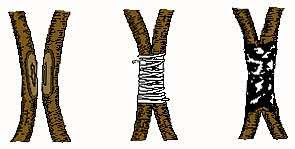Mango is one of the high potential food crop in India. it is suitable for different Agro ecological zones ranging from sub humid to semi arid.
PropagationMango is a highly heterozygous and cross polluted crops.There are two types of varieties namely Monoembryonic and Polyembryonic. Polyembryonic varieties can be propagated through seeds because they produced true to type varieties seedlings, where monoembryonic needs to propagated vegetatively.All commercial varieties are monoembryonic only.Mango is vegetatively propagated through layering, grafting and tissue culture but approach grafting and epicotyl grafting techniques are commercially used among farmers.
A full knowledge about the effect using species of Manifera and other genera of rootstock is not available.Polyembryonic which are uniform among themselves they reduce variability due to root stock. Clonal root stock have not been on trial but rooting of mango cuttings and layers with hormones have scope in selection of rootstock for mango.
Mango seeds of Alphonso are collected immediately after extraction of pulp in nearby processing industries.The collected seeds have to sown on same day in well ploughed sandy loam soil beds and irrigtaed. Two or three month after germination they can be used for stone grafting.six month old seedlings can be used for soft wood grafting and nine month to one year old rootstock ae used for approach grafting .
Grafting techniques:
- Approach grafting is also known as Inarching.
- This method is extensively practiced in Tamilnadu.
- In this method we bring the rootstock to Scion area .The scion is taken to rootstock area.
- Nine month to one year old rootstock is grafted with Scion which remains attached to mother plant .
- In root stock 20 cm above the ground level,5 cm long slice of bark with wood is removed and cut is made in scion.so as to unite cut surface firmly with jute thread. The tide portion is covered with cow dung mud paste.
- The graft is separated from the mother plant after 70-80 days.
- The grafts are then planted in polyethylene bags containing potting mixture and kept in the shade to protect from heavy rain.
Epicotyl or stone grafting
- Epicotyl grafting is also known as Stone grafting which is simple, cheap and quick method of Mango propagation.
- The success rate of epicotyl grafting is75-80%.
- The stones or seed should be sown in June-July on raised beds of size 1x3 m where the bed contain 2:1 of soil and FYM.
- After germination, seedlings with tender stems having coppery leaves are lifted with stones which is still attached.
- To prevent from soil pathogens the roots and stones are dipped in O.1 per cent Carbendazirn solution for 5 minutes after washing the soil.
- The seedling stems are headed back leaving 6-8 cm long stem and 4-6 cm longitudinal cut is made running down through the middle of the stem.
- A wedge shaped cut on both sides is made on the lower part of scion stick.
- The scion stick should be 4-5 months old.
- The Scion stick is 10-15 cm long contain plumpy terminal buds.
- The scion stick is then inserted in the cleft of the seedlings and tied with polythene cover.
- The grafts are then planted in polyethylene bags containing potting mixture and kept in the shade to protect from heavy rain.
- The scion stars sprouting 15-20 days after grafting.
- July is the most suitable month for stone grafting





0 Comments
Avoid spam and abuse🙌